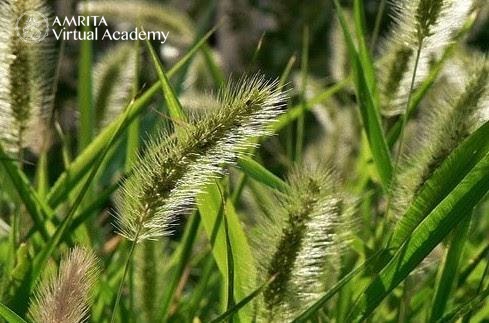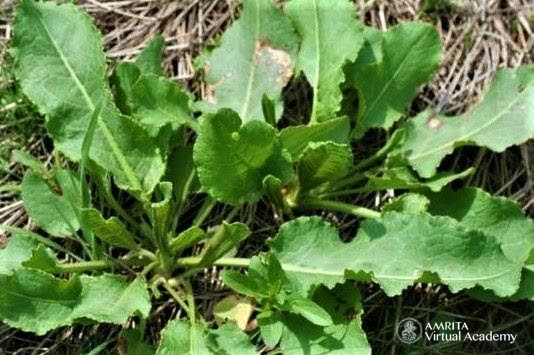
How to Read a Weed
“Nature is a mystery to us. Many ayurvedic herbs and plants look to us like useless weeds. Out of ignorance we destroy them. But a knowledgeable ayurvedic physician knows how useful and significant they are.” -Amma
What are weeds and what can they tell us?
We commonly think of weeds as unwanted invaders of our lawn and gardens. They tend to show up where we least want them. In truth, weeds are plants with abundant good qualities and provide us with useful information. By observing weeds, they can help us see the unseen.

Weeds are Nature’s soil protectors, (2).
Weeds are fast plants. They get established fast, grow fast, and put out seeds fast. This speed gives them the ability to cover bare soils with immediacy. They are like band aids. They protect bare soil from water evaporation, erosion and irradiation from the sun, (2). They bring quick repair to damaged soils, initiating regrowth and restoration. So, if you see a bunch of weeds covering the ground you might just wonder what happened there? And what is happening there now? You may want to let them be.
Weeds are hardy and can often survive where other plants cannot. This hardiness imbues weeds with a lot of strength; hence they have qualities that in turn strengthen us when we ingest them or use them on our bodies. Not only Ayurvedic and Naturopathic doctors understand the value of weeds, but gardeners have learned to make use of these sturdy growers as well. By observing both the plant structure and the community of plants growing in an area we can learn many useful things from weeds.

Listen with your eyes.
If you look closely at the shape, texture or appearance of the leaves of weeds, they can indicate how to use the plant. For instance, Mullen has broad, long, fuzzy leaves that look like lungs. A tea made out of the leaves is good for coughs, asthma and congestion. It was also used to treat tuberculosis in the 18th century. If it was given early on in the disease it was known to bring about full recovery, (1). Today it has been found scientifically to have saponins that act as an expectorant. It also has antibacterial properties, (1).

Plantain on the other hand, has a leaf structure that has long veins. Sometimes the leaves even look like the hood of a snake about to bite! Plantain is indicated for immediately addressing snake bites until you are able to get an antivenom. Plantain is in general good for most skin problems such bee stings, small wounds and itching; it pulls poisons out of the skin as these long veins imply. Just make a spit poultice. Pluck a leaf, chew it up for a bit and apply it to the wound or affected area. These visual cues help us remember the medicinal value inherent in these mysterious plants.
Weeds also help us understand soil.
If we observe the species of weeds that grow in an area, it can tell us about the soil conditions. We only see the soil’s surface but there is a vast invisible universe underneath. Weeds give us information about that unseen world. It can tell us about the microbial populations, soil structure and pH underground. For instance, a large population of low-lying weeds indicate a bacterially dominated soil population. Hence, the soil will have a higher pH and be more alkaline due to the bacterial secretions.
Want to learn more about gardening in the spirit of Amma’s teachings? Visit here.
Gardeners have long studied weeds as a means of understanding soil conditions. They take into consideration the underground factors that make it easy for those weeds to grow.

Weeds can point to the structure of the soil; is it compacted, dry or soggy. I remember a patch of horsetail growing on one edge of an ornamental bed where I was working as a gardener. I wondered why it was there. At some point, I saw some more growing in a drainage ditch nearby and then the thought came to me, “of course it would grow there. It likes soggy wet soil, so that patch on the edge of the bed must be soggy too.”
Tall grassy weeds can indicate a mix of bacteria and fungi in the soil and a more neutral pH. Conversely, a lack of weeds can indicate fertile soil with a higher fungal content.
Further investigation into the weed species present can help us make decisions about how to amend the soil, so we can better grow in that area. Soggy areas will need drainage. Dry areas will need creative earthworks such as swales and mulch. For the purposes of determining soil health, close observation over time is needed. Weeds that grow in large numbers over a long period of time are the best indicators of soil conditions.
Below are some examples of weeds and the soil conditions they indicate, (3).

Weeds that indicate dry depleted soils:
Plantain can do well in disturbed soil that is dry and lacking in nutrients. Heavy clay may also be present.

Weeds that indicate soil compaction:
Foxtail, and fall panicum, which are grassy weeds multiply in soil that is compacted, has poor structure, and is dry.

Weeds that indicate soggy soil:
Yellow Dock and goldenrod grow best in wet, poorly drained soil, and near swampy areas. Horsetail, shown way above, also grows in poorly drained acidic soils.
Whether we are a doctor, a gardener or if we just like to walk in nature, learning to read weeds can help us to better understand how to interact with our environment for our mutual benefit.
References
- Health benefit Times, 2021, Health Benefits of Great Mullin, accessed Apr. 25, 2021, www.healthbenefitstimes.com
- Walker, John, 2016, How Weeds Heal Bare Soil. Nov. 4, 2016, The Guardian, accessed Oct. 16, 2020
https://www.theguardian.com/lifeandstyle/gardening-blog/2016/nov/04/how-weeds-heal-bare-soil - Walters, Charles, 2020, What Weeds Tell Us About Soil, Eco Farming Daily, accessed Aug.12.2020 https://www.ecofarmingdaily.com/eco-farming-index/weeds-and-your-soil/
Medical Disclaimer
No Amritaculture article, video, blog, post or comment should be considered health advice. You are responsible for consulting a medical professional before trying any new foods, herbs, weeds mentioned in the course or any related forum. We are educators, not doctors. Plant information is shared to increase your awareness and not to treat, diagnose, or be used as medical advice.
